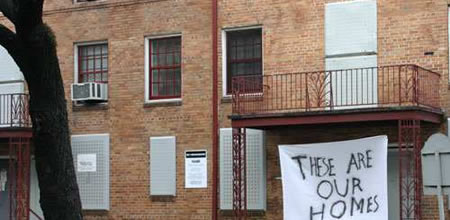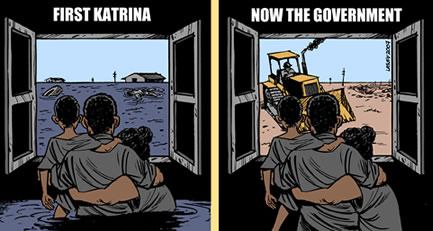Posted December 11, 2007

Image from New Orleans IndyMedia
Saturday December 15 will begin the official demolition process of some 4600 public housing units. Hundreds of activists- many from around the country-will be awaiting the crews that arrive for demolition preparations.
Less than a mile away from two of the housing developments, dozens of red tents blanket the green space of City Hall’s Duncan Plaza, providing refuge for hundreds of the city’s 12,000 or more homeless residents. The homeless population has more than doubled since Hurricane Katrina. Many of those who sleep on the city’s streets, underpasses, in cars, and in parks had homes before the hurricane, while rents have more than doubled in the last 2 ½ years.
Meanwhile, thousands of former homeowners and their families are combing through want ads for housing from the cramped space of FEMA trailers, from which they will be evicted en mass in coming weeks.
Only a few days before Christmas, New Orleans is facing a housing crisis of epic proportions. The dire state of housing in New Orleans is owes much to decades of brutal economic and social policies which have played out in cities across the US. However, the particular intensity of the New Orleans crisis is the result of free market policies run amok: privatization, a lack of adequate transitional housing, and a failure to regulate rental costs in a city where 80% of the housing stock was damaged.
Over 100 activists pack city planning meeting
There is resistance. On Monday December 10, over 100 activists packed a city planning meeting to ask for a stay of city issued demolition permits for three of the four housing developments. This comes on the heels of rising militancy among housing activists. On Thursday December 6, dozens of public housing residents and their supporters disrupted a New Orleans City Council meeting, leading to the arrest of prominent human rights lawyer Bill Quigley. On Sunday December 9, 150 people marched on the home of Mayor Nagin to protest his lack of compassion, awarding him a lump of coal.
Civil disobedience training is being held for the activists arriving from out of town, but more importantly, local organizers are putting together coalitions that include influential public housing residents. How many residents will ultimately become involved in this struggle is hard to say, as many are still displaced. A serious concern among long-term organizers is a substitution-ism where mostly white youth with little connection to the city are arriving in droves, while residents have not yet shown up in similar numbers.
Long Decline and 2 ½ Years of Crisis
This is but the latest battle in a long fight against the destruction of public housing in New Orleans. Policymakers at the city and federal level (HANO and HUD) have been moving to destroy public housing as we know it for some time. These entities used the storm as an excuse to shutter public housing and put up large chain link fences and metal plates over doors, preventing residents from returning.

In June of 2006, HUD Secretary Alphonso Jackson first announced that the four developments would be torn down and replaced with “mixed-use” redevelopments. Since Katrina, a fledgling movement to re-open public housing succeeded in mobilizing dozens of public housing residents and hundreds of supporters on Martin Luther King day, January 15, 2007 to tear down a fence surrounding the St. Bernard housing development and a cleaning and symbolic moving in of residents. This lead to a ten-day occupation of a building in the complex by out-of-town white activists starting that day. A number of lawsuits have been filed since then, however to date the best these lawsuits have done is force HANO to open a limited number of units in certain projects slated for demolition and to spare less than 20% of the units in those four developments.
While many in the city see the need for public housing to be reopened as a temporary measure it does not enjoy enough broad public support. Public housing is still seen by many, white and black, as a haven for criminals and an unfortunate concentration of New Orleans’ poorest. Negative stereotypes about public housing residents are common, many unfounded— such as the myth that most residents of public housing are unemployed drug dealers. In reality, of course, most are families headed by employed single mothers who earn poverty wages.
For updates, visit Justice for New Orleans, Defend New Orleans Public Housing, and New Orleans Indymedia

Comments
3 responses to “Bulldozers set to destroy public housing in New Orleans: Tens of thousands homeless”
From Big Noise Tactical Media, a new short video featuring direct action, marches, and interviews with residents of public housing, homeless folks in Duncan Plaza, and more.
http://www.youtube.com/watch?v=mygOYj6NcR8
New Orleans Police Attack Peaceful March at St. Bernard:
http://www.youtube.com/watch?v=9GPjNhVUzqk
It is disheartening the bad rap public housing residents tend to get. The only way to combat it is for they themselves to organize so as to present a different face. I commend the activists trying to build such a movement.
My neighborhood in Detroit also has a very high number of single women led households. This means lots of young people and therefore youth organizing is key. I am white single mother UAW (United Automobile Workers) activist and have lived here for 30 years. When I moved in it was already 80% African American. I’m glad to have such a long history in the neighborhood. Now that I’m retired, I had the time to initiate a block club 2 years ago that has developed a healthy level of participation. It has improved morale in the neighborhood considerably with the active members mainly being the long time residents like myself.
Vacant houses are a major issue right now. Unlike New Orleans which doesn’t have enough housing, we don’t have enough people! This is of course due to the loss of jobs in the auto industry. Population decline in Detroit has been going on for many years now. In sections of the city, entire blocks of houses have been torn down. Now with the high number of foreclosures in the last year, there is a new round of devastation. There are five houses at the other end of my block that are vacant and open. They use to be rentals, and we figure they went vacant because renters have a lot more to choose from. You would think that foreclosures would lead to more rentals.
We contacted the owners and the city and can’t get them boarded up. Many houses have aluminum siding and get stripped. Then they really look horrible! Even neighborhoods with beautiful brick houses have many vacant houses. Probably these neighborhoods were hit more with sub-prime as people tried move to nicer places that were beyond their means.
You have a lot of vacancy in the suburbs also so people find “good deals” out of the city. This also encourages the exodus. Organizers have an increased interest in city farming with so much vacant land! People are thinking corn for ethanol would be perfect since you would not have to worry about polluted land!
Corn does not have a positive appeal in the neighborhood since people think it would be easy to have someone hide in the tall corn and grab you as you walk by! Everything would have to be fenced in! People have the same negative reaction to turning sections of the city into woods.
It hard to imagine where we go from here, but there are people like myself many retired who have dug in their heels and are not interested in uprooting, but the problem can seem overwhelming.
The movement in New Orleans is an inspiration to us all and symbolic of what’s happening in society as a whole. They need the tourist industry there and with that they need labor, which cannot be “outsourced” so along with the community-based movements perhaps a labor movement can develop also.
Wendy Thompson, retired former President, L. 235, UAW, American Axle, Detroit Gear & Axle
Here in Seattle we have some of the same issues but also have the benefit of previous struggles and long term organization. Though Seattle like the rest of the US was a racially red-lined city, we at least aren’t under the attack of Disaster Capitalism.
Affordable and public housing is under attack. Even market rate housing is becoming scarce in Seattle as literally thousands of units are being converted from apartments into condos. This forces the current apartment dwellers out of their apartments unless they become suckers for subprime loans to buy what they were renting. Reformers have suggested legislation limiting condo conversion, which exists in San Francisco, but the Washington state Democratic Party refuses to use its supermajority in the state legislature to help out even the “middle class” they fawn over.
We’ve also had to protect public housing from being “redeveloped.” It is amazing how “redevelopment” always means fewer units of housing. So far the Yessler Terrace units have been protected.
All the same just this week, under pressure from tenant activists, the Seattle Housing Authority used its power of imminent domain to purchase threatened housing and either make it public, or find a developer that would keep it as affordable rentals. That is the fifth time in the past few years that SHA has used its power of imminent domain to preserve public housing. A lot of this good news has come from the work of the Displacement Coalition, a local activist/nonprofit that works with tenants to preserve housing, both in lobbying public authorities and broader community campaigns. I’m happy to say that the local Greens are working with the Displacement Coalition and that a relationship is developing.
Jon H Seattle
X-tech worker, hoping that he can find his place as a gramscian organic intellectual amongst nurses…
Currently living in a housing co-operative.